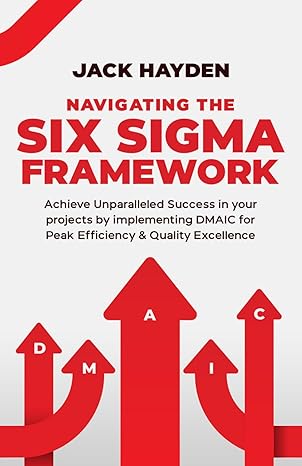
- The book provides a practical guide to Six Sigma’s DMAIC process, aiming to streamline operations, reduce waste, and enhance customer satisfaction.
- Suitable for all experience levels, it offers clear, actionable steps and real-world examples across diverse industries, including healthcare and manufacturing.
- Beginners may find it especially accessible, with easy-to-follow instructions, visual aids, and a balanced mix of theory and practical application.
Navigating the Six Sigma Framework: Achieve Unparalleled Success in Your Projects by Implementing DMAIC for Peak Efficiency and Quality Excellence by Jack Hayden offers a comprehensive guide to the Six Sigma methodology. Aimed at improving business processes and quality management, this book emphasizes the DMAIC (Define, Measure, Analyze, Improve, Control) methodology. It highlights the origins and widespread adoption of Six Sigma, particularly in high-performance organizations like those in the Fortune 500. The author outlines essential steps to implement DMAIC effectively, covering everything from defining project scope to measuring outcomes and applying tools to analyze root causes, all designed to reduce inefficiencies and enhance customer satisfaction. The book is tailored for professionals at all levels, providing practical advice, real-world examples, and insights into Six Sigma’s adaptability across various industries, regardless of company size.
The book is especially valuable in demonstrating how to streamline operations and reduce waste. The guide’s structured format, reliance on real-world applications, and clarity in delivering Six Sigma principles could make it a useful reference for both newcomers and experienced professionals looking to enhance efficiency and quality in their projects. Rather than work in one industry, the book has applicability across diverse sectors. The book provides step-by-step guidance in implementing DMAIC, particularly examples that illustrate how these principles apply in industries such as manufacturing, healthcare, and small businesses. It includes chapters on data collection and analysis, as well as the importance of understanding root causes in problem-solving, a popular topic among quality professionals.
Compared to more complex references, the book appears particularly accessible for Six Sigma beginners. It provides a breakdown of key terms and step-by-step guidance on Six Sigma tools like process mapping and data analysis with the data collection and analysis sections as potentially valuable for better productivity and goal-setting. The book balances of theory with actionable strategies, including visual aids and case studies that help explain the Six Sigma process. The work also provides historical context, stating that the background information clarified why Six Sigma continues to be relevant.
That said, at first reading, some may see undo complexity in explanation of specific concepts, such as statistical elements, though the author’s explanations seem to ultimate resolved initial confusion. Alternatively, some seasoned professionals may view the book served better as an introductory guide rather than a deep dive but hopefully may still consider it valuable for its comprehensive overview.


Leave a Reply
You must be logged in to post a comment.